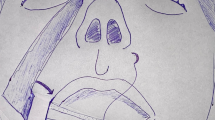Abstract
In addition to all the consequences mentioned elsewhere in the literature, the aging process causes the most dramatic changes in the midface and nasolabial complex. Genetic predisposition also plays a role in the final appearance of this area. The nasolabial complex in the aged face generally is accepted as a “hard-to-treat area” for which many different techniques have been described. Among the techniques described to date, direct excision still keeps its popularity for selected patients. However, some controversies in the technique are open to discussion. To overcome these problems, we did skin excision, reshaping and repositioning the fibrofatty tissue lateral to the fold, which is contrary to fat excision in the classical technique. It seems to be a better approach to reshape and reposition the ptotic tissue so as not to obliterate but rather to smooth out the nasolabial area. Excision of fat would decrease the amount of tissue in the already atrophic and ptotic face. This technique offers a new approach to nasolabial complex problems. The most significant drawback is the scar, which usually is imperceptible in selected patients.
Similar content being viewed by others
References
SR Baker (1997) ArticleTitleTriplane rhytidectomy Arch Otolaryngol Head Neck Surg 123 1167–1172
K Conrad MR MacDonald (1996) ArticleTitleWide polytef (Goretex) implants in lip augmentation and nasolabial groove correction Arch Otolaryngol Head Neck Surg 122 664–670
K Conrad E Reifen (1992) ArticleTitleGoretex implant as tissue filler in cheek–lip groove rejuvenation J Otolaryngol 21 218–222
DAF Ellis CD Bakala JN Harlock (1997) ArticleTitleAnalysis of the perioral complex Facial Plast Surg Clin North Am 5 1–6
S Eremia N Newman (2000) ArticleTitleLong-term follow-up after autologous fat grafting: Analysis of results from 116 patients followed at least 12 months after receiving the last of a minimum of two treatments Dermatol Surg 26 1150–1158
MS Freeman (1997) ArticleTitleEndoscopic malar pad lift Facial Plast Surg Clin North Am 5 29–42
DW Furnas (1995) ArticleTitleStrategies for nasolabial levitation Clin Plast Surg 22 265–278
B Guyuron (1995) ArticleTitleThe armamentarium to battle recalcitrant nasolabial fold Clin Plast Surg 22 253–264
B Guyuron B Michelow (1994) ArticleTitleThe nasolabial fold: A challenge, a solution Plast Reconstr Surg 93 522–529 Occurrence Handle1:STN:280:ByuC2MbnsVM%3D Occurrence Handle8115507
JN Harlock DAF Ellis (1997) ArticleTitleEffacement of the deep lip–cheek groove with Goretex Facial Plast Surg Clin North Am 5 7–11
FM Kamer AS Frankel (1997) ArticleTitleDeep plane face-lift for improvement of the lateral oral groove Facial Plast Surg Clin North Am 5 23–28
GS Keller J Cray (1996) ArticleTitleSuprafibromuscular face-lifting with periosteal suspension of the superficial musculoaponeurotic system and fat pad of Bichat rotation Arch Otolaryngol Head Neck Surg 122 377–384
C Lassus (1996) ArticleTitleA surgical solution to the deep nasolabial fold Plast Reconstr Surg 97 1473–1478
JR Lupton TS Alster (2000) ArticleTitleCutaneous hypersensitivity reaction to injectable hyaluronic acid gel Dermatol Surg 26 135–137
DR Millard RTW Yuan JW Devine (1987) ArticleTitleA challenge to the undefeated nasolabial folds Plast Reconstr Surg 80 37–46
H Mittelman (1997) ArticleTitleAnatomically designed silastic implants for the melolabial groove Facial Plast Surg Clin North Am 5 13–22
G Rudkin T Miller (1999) ArticleTitleAging nasolabial fold and treatment by direct excision Plast Reconstr Surg 104 1502–1505 Occurrence Handle1:STN:280:DyaK1Mvkt1Sqtg%3D%3D Occurrence Handle10513936
S Singh JL Baker (2000) ArticleTitleUse of expanded polytetrafluoroethylene in aesthetic surgery of the face Clin Plast Surg 27 579–593
LF Smith MJ Hoff (1996) ArticleTitleA new procedure for improvement of the ptotic melolabial fold Arch Otolaryngol Head Neck Surg 122 1088–1093
C Wolf (1997) ArticleTitleExcision of the nasolabial fold Facial Plast Surg Clin North Am 5 43–46
Author information
Authors and Affiliations
Corresponding author
Rights and permissions
About this article
Cite this article
Sen, C., Cek, D.I. & Reis, M. Direct Skin Excision Fat Reshaping and Repositioning for Correction of Prominent Nasolabial Fold. Aesth Plast Surg 28, 307–311 (2004). https://doi.org/10.1007/s00266-004-3133-3
Published:
Issue Date:
DOI: https://doi.org/10.1007/s00266-004-3133-3



